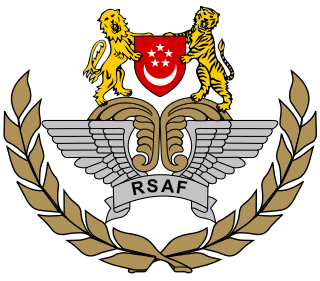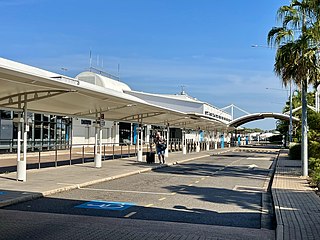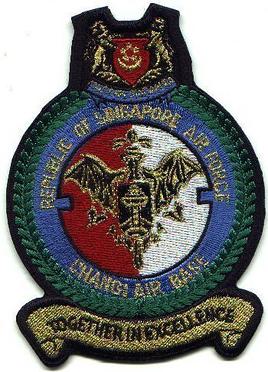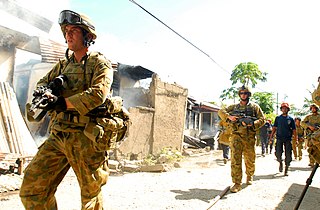Related Research Articles

The Republic of Singapore Air Force (RSAF) is the aerial service branch of the Singapore Armed Forces (SAF) responsible for controlling and defending the airspace of the country, and providing air support to the Army and Navy. It was established in 1968 as the Singapore Air Defence Command (SADC) before renaming to its current name in 1975.
The Rim of the Pacific Exercise (RIMPAC) is the world's largest international maritime warfare exercise. RIMPAC is held biennially during June and July of even-numbered years from Honolulu, Hawaii, with the exception of 2020 where it was held in August. It is hosted and administered by the United States Navy's Indo-Pacific Command, headquartered at Pearl Harbor, in conjunction with the Marine Corps, the Coast Guard, and Hawaii National Guard forces under the control of the Governor of Hawaii.

The Five Power Defence Arrangements (FPDA) are a series of bilateral defence relationships established by a series of multi-lateral agreements between Australia, Malaysia, New Zealand, Singapore, and the United Kingdom, all of which are Commonwealth members that once belonged to the British Empire.

The Tengah Air Base is a military airbase of the Republic of Singapore Air Force (RSAF) located in the Western Water Catchment, in the western part of Singapore.

The Pacific Aerospace Corporation CT/4 Airtrainer series is an all-metal-construction, single-engine, two-place with side-by-side seating, fully aerobatic, piston-engined, basic training aircraft manufactured in Hamilton, New Zealand.

Darwin International Airport is a domestic and international airport, and the only airport serving Darwin, Australia. It is the eleventh busiest airport in Australia measured by passenger movements.

Changi Air Base (East), or Changi East Complex, is a facility extending the facilities of Changi Air Base, the existing facilities hence renamed Changi Air Base (West). Built on a 2 square kilometre site of reclaimed land, the new base was located approximately 2 kilometres east of Changi Airport and approximately 1.5 kilometres west of Changi Naval Base. Groundbreaking took place on 15 July 2002 and it was officially opened on 29 November 2004. A new runway (02R/20L) was built and the length was approximately 2,748 metres (9,015 ft), it has since been lengthened to 4,000 metres.

RAAF Base Pearce is the main Royal Australian Air Force (RAAF) military air base in Western Australia, located in Bullsbrook, north of Perth. It is used for training by the RAAF and the Republic of Singapore Air Force.

The International Force East Timor (INTERFET) was a multinational non-United Nations peacemaking task force, organised and led by Australia in accordance with United Nations resolutions to address the humanitarian and security crisis that took place in East Timor from 1999–2000 until the arrival of UN peacekeepers. INTERFET was commanded by an Australian military officer, Major General Peter Cosgrove.

No. 75 Squadron is a Royal Australian Air Force (RAAF) fighter unit based at RAAF Base Tindal in the Northern Territory. The squadron was formed in 1942 and saw extensive action in the South West Pacific theatre of World War II, operating P-40 Kittyhawks. It was disbanded in 1948, but reformed the following year and operated jet aircraft throughout the Cold War. The squadron was based at Malta from 1952 to 1954, flying de Havilland Vampires, and Malaysia from 1968 to 1983, with Dassault Mirage IIIs, before returning to Australia.

RAAF Base Tindal also known as Tindal Air Base is a Royal Australian Air Force (RAAF) military air base and civil aviation airfield located 8 nautical miles east southeast of the town of Katherine, Northern Territory in Australia. The base is currently home to No. 75 Squadron and a number of non-flying units, and also hosts the civilian Katherine Tindal Airport. First constructed in 1942, it was refurbished in the late 1960s as a bare base capable of being utilised when required. It was opened as a permanently manned RAAF base in 1989.

No. 79 Squadron is a Royal Australian Air Force (RAAF) flight training unit that has been formed on four occasions since 1943. The squadron was established in May 1943 as a fighter unit equipped with Supermarine Spitfires, and subsequently saw combat in the South West Pacific theatre of World War II. Between June 1943 and the end of the war in August 1945 it flew air defence patrols to protect Allied bases and ships, escorted Australian and United States aircraft, and attacked Japanese positions. The squadron was disbanded in November 1945, but was re-formed between 1962 and 1968 to operate CAC Sabres from Ubon Air Base in Thailand. In this role it contributed to the defence of Thailand against a feared attack from its neighbouring states and exercised with United States Air Force units. No. 79 Squadron was active again at RAAF Base Butterworth in Malaysia between 1986 and 1988 where it operated Mirage III fighters and a single DHC-4 Caribou transport during the period in which the RAAF's fighter squadrons were transitioning to new aircraft.

No. 10 Squadron is a Royal Australian Air Force (RAAF) signals intelligence (SIGINT) squadron based at RAAF Base Edinburgh, South Australia. It is part of No. 92 Wing RAAF. The squadron was formed in 1939 as a maritime patrol unit. It saw active service during the Second World War, conducting anti-submarine operations and patrols from bases in the United Kingdom until it disbanded in late 1945. It was re-formed in Australia in 1949 and since then has contributed to Australia's East Timor intervention, and has been deployed to the Middle East as part of the War on Terrorism and the 2003 Gulf War. Most recently it now has a signals intelligence mission.

Operation Astute was an Australian-led military deployment to East Timor to quell unrest and return stability in the 2006 East Timor crisis. It was headed by Brigadier Bill Sowry, and commenced on 25 May 2006 under the command of Brigadier Michael Slater. The operation was established at the request of East Timor's government, and continued under an understanding reached between Australia, East Timor, and the United Nations, with the United Nations Integrated Mission in East Timor supporting and helping to develop East Timor's police force. Other countries deploying soldiers to East Timor include Malaysia, New Zealand and East Timor's former colonial power Portugal, operating under independent command.

RMAF Butterworth is an active Air Force Station of the Royal Malaysian Air Force (RMAF) situated 4.5 nautical miles from Butterworth in Penang, Malaysia. It is currently home to the Headquarters Integrated Area Defence System (HQIADS), part of the Five Power Defence Arrangements (FPDA).
The Darjah Utama Bakti Cemerlang (Tentera) is a decoration awarded to members of the Singapore Armed Forces and allied military members for exceptionally distinguished service or merit in senior command or staff positions.

The CAC Sabre, sometimes known as the Avon Sabre or CA-27, is an Australian variant of the North American Aviation F-86F Sabre fighter aircraft. The F-86F was redesigned and built by the Commonwealth Aircraft Corporation (CAC). Equipping five Royal Australian Air Force (RAAF) squadrons, the type saw action in the Malayan Emergency in the late 1950s and was employed for air defence in Malaysia and Thailand in the 1960s. Ex-RAAF models also saw service with the Royal Malaysian Air Force and the Indonesian Air Force.

Air Chief Marshal Mark Donald Binskin, is a senior officer in the Royal Australian Air Force Reserve. He served as Chief of Air Force (2008–11), Vice Chief of the Defence Force (2011–14), and Chief of the Defence Force from June 2014 until his retirement in July 2018. In February 2020 he was appointed as a Commissioner and Chairman of the Royal Commission into National Natural Disaster Arrangements. He is the current chair of the Civil Aviation Safety Authority of Australia.

The Indonesia–Malaysia confrontation was fought from 1962 to 1966 between the British Commonwealth and Indonesia. Indonesia, under President Sukarno, sought to prevent the creation of the new Federation of Malaysia that emerged in 1963, whilst the British Commonwealth sought to safeguard the security of the new state. The war remained a limited one however, and was fought primarily on the island of Borneo, although a number of Indonesian seaborne and airborne incursions into the Malay Peninsula did occur. As part of Australia's continuing military commitment to the security of Malaysia, Australian army, naval and air force units were based there with the Far East Strategic Reserve, mainly in the 28th Commonwealth Infantry Brigade Group.
References
- ↑ Pitch Black 2016, Part 1 photo recon.net Retrieved 4 November 2016.
- ↑ "Singapore Participates in Exercise Pitch Black 2006". MINDEF Singapore. 1 August 2006. Retrieved 7 October 2016.
- ↑ "Singapore Participates in Ex Pitch Black". MINDEF Singapore. 25 June 2008. Retrieved 7 October 2016.
- ↑ RSAF Participates in Multilateral Air Combat Exercise in Darwin 24 July 2010 mindef.gov.sg Retrieved 5 October 2016
- ↑ Exercise Pitch Black 2012 concludes 20 August 2012 airforce-technology.com Retrieved 5 October 2016
- ↑ Indonesian Flankers touch down in Darwin Australian Aviation Retrieved 4 December 2016
- ↑ PACAF supports Pitch Black 2014 in Australia 31 July 2014 Pacific Air Forces Retrieved 5 October 2015
- ↑ Air Force exercise Pitch Black takes off over Darwin and Katherine, residents brace for noise 2 August 2014 ABC Retrieved 5 October 2016
- ↑ Pitch Black 2016 begins 1 August 2016 Australian Aviation Retrieved 5 October 2016
- ↑ "Exercise Pitch Black". Royal Australian Airforce. Retrieved 3 September 2018.
- ↑ IndraStra Global (15 August 2018), Exercise Pitch Black 2018 — RAAF-IAF Co-Fly, archived from the original on 14 December 2021, retrieved 21 November 2018
- ↑ "IAF PARTICIPATION IN EX PITCH BLACK 2018". Indian Air Force. Retrieved 3 September 2018.
- ↑ "Exercise Pitch Black 2022". Royal Australian Air Force . Retrieved 14 September 2022.
- ↑ "Exercise Pitch Black 2022". Royal Australian Air Force . Retrieved 14 September 2022.
- ↑ Waters, Savannah (12 September 2022). "Pitch Black 2022 concludes international interoperability exercise". United States Air Force . Retrieved 14 September 2022.
- ↑ "Largest ever Pitch Black drills take off – Asian Defence Journal". 11 July 2024. Retrieved 15 July 2024.
- ↑ "Australia set to begin largest Exercise Pitch Black 24 - AeroTime". 11 July 2024. Retrieved 15 July 2024.
- ↑ Pittaway, Nigel (8 July 2024). "In first, Australian exercise Pitch Black gets dedicated aircraft carrier". Defense News. Retrieved 15 July 2024.
- ↑ Charpentreau, Clement (24 July 2024). "Italian Typhoon crashes during Exercise Pitch Black" . Retrieved 24 July 2024.
- ↑ "Military aircraft crashes in remote NT during multinational defence exercise". ABC News. 24 July 2024.